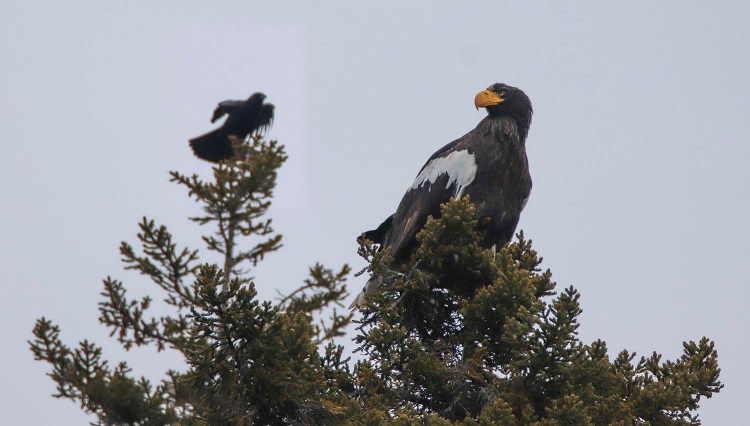At the end of December, an unusual visitor turned up in Georgetown. It was a Steller’s sea eagle – the first of its kind ever to have been seen in the continental United States. With fewer than 5,000 of these birds estimated to exist in the entire world, they’ve hardly been seen anywhere outside of their traditional home in Siberia. Needless to say, the bird’s appearance on the coast of Maine made quite an impression.
If you’re one of the thousands of Mainers (and ecotourists!) fortunate enough to have seen the Steller’s sea eagle, you know that a big part of that impression is due to its striking appearance. With a wingspan of 8 feet, this bird makes our normally imposing American bald eagles look almost petite. Its bold white markings on a deep brown body are as distinctive as they are sleek, and its colossal, curved, bright yellow beak underscores its hunting prowess.
Perhaps as important to the impression this bird made in Maine and beyond is the sheer improbability of its presence. There are many theories about why birds show up far outside their normal ranges, from storms blowing them off course to neurological issues affecting their navigation instincts. But while we may never know why the Steller’s sea eagle came to Maine, no one should be surprised that it stayed as long as it did.
The area where this bird settled for three months – in and around the mouth of the Kennebec River, just downstream of Merrymeeting Bay near the towns of Boothbay, Arrowsic and Bath – is blessed with a forested coastline and waters teeming with fish and wildlife. Forty percent of Maine’s fresh water drains through Merrymeeting Bay. If you were an apex avian predator with a high tolerance for cold and a taste for fish, it might be hard to imagine a better spot.
The fact that such vibrant wildlife habitat is thriving amidst increasing development in Midcoast Maine is no accident. Far from it – it’s actually the result of decades of dedicated work by conservation groups, local leaders and municipal, state and federal government, all supported by Maine voters. The story of conservation in the Merrymeeting Bay region is one of dire threats, high stakes and incredible collaboration.
In the second half of the twentieth century, development pressures in the Midcoast were increasing at a rate four times greater than the state average. As farms and forests were converted to residential uses, wildlife faced the challenges brought on by new roads, homes, pets and people. Water pollution was a very real problem, and the effects of chemicals like DDT were posing a dire threat to wildlife. On the first “Bald Eagles of Merrymeeting Bay” boat trip led by Maine Audubon in 1969, there were only two documented nesting pairs on the Bay.
Since then, the ecological health around the Bay has improved dramatically. Efforts by local organizations like the Kennebec Estuary Land Trust, Phippsburg Land Trust and Brunswick-Topsham Land Trust have doubled the amount of conserved land in the past 20 years. The teams we lead at the Maine Department of Inland Fisheries and Wildlife and The Nature Conservancy in Maine have been proud to support these local efforts, and the U.S. Fish & Wildlife Service has been instrumental as well. Today, there are over 30 nesting eagle pairs in the area, and passengers on Maine Audubon’s annual boat trip regularly tally over 60 eagles.
Perhaps this year, the Steller’s sea eagle will be among them! Despite recently being spotted in Nova Scotia, this magnificent bird’s extended visit is an important reminder of the successes Mainers have achieved to conserve our natural lands and waters. As we confront the future, including a warming and unstable climate, our connected and resilient ecosystems will be crucial to our ability to survive and thrive. Together, we can ensure Maine remains a place everyone wants to visit and stay – avian or otherwise!
Send questions/comments to the editors.



Success. Please wait for the page to reload. If the page does not reload within 5 seconds, please refresh the page.
Enter your email and password to access comments.
Hi, to comment on stories you must . This profile is in addition to your subscription and website login.
Already have a commenting profile? .
Invalid username/password.
Please check your email to confirm and complete your registration.
Only subscribers are eligible to post comments. Please subscribe or login first for digital access. Here’s why.
Use the form below to reset your password. When you've submitted your account email, we will send an email with a reset code.